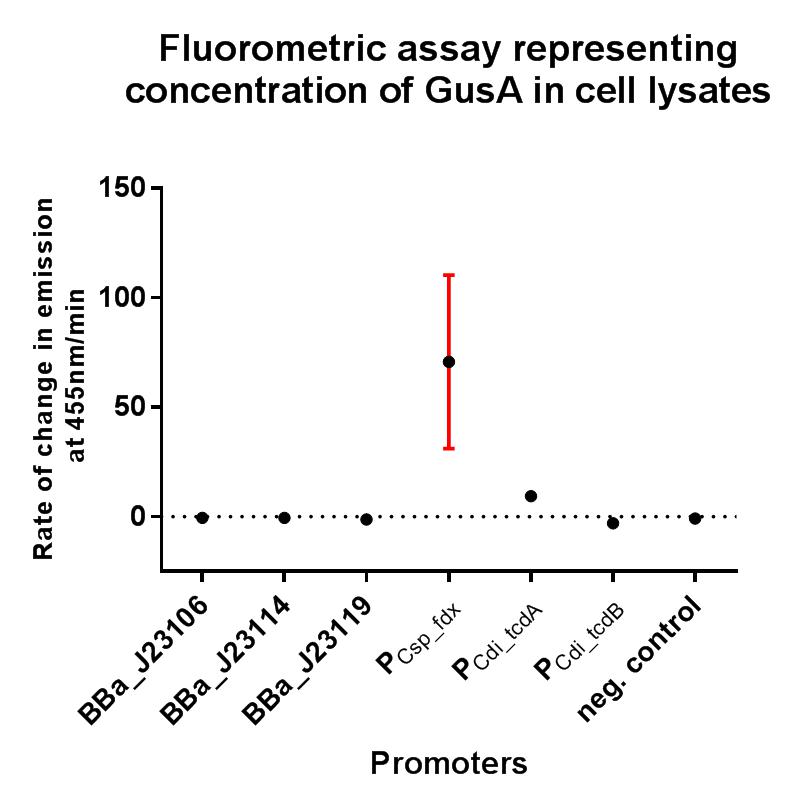Part:BBa_K2715031
Constitutive E.coli promoter BBa_J23119, strong RBS and GusA reporter
Usage and Biology
We wanted to test whether the widely used E. coli promoter BBa_J23119 would function well in our non-model organism Clostridium difficile, as we required a range of strong promoters for our toxin silencing strategies. For characterisation in C. difficile we decided to use the reporter gene gusA, as the GFP protein requires oxygen in order to fluoresce, so it isn’t suitable as a reporter gene in this context. The Β-Glucuronidase encoded by gusA functions as a very sensitive and specific reporter gene in anaerobic organisms. A substrate for the Β-Glucuronidase, 4-methylumbelliferyl glucuronide (4-MUG), can be added to the cell lysate immediately before the assay, and the production of the fluorescent compound 4-methylumbelliferone (4-MU) measured over time in a spectrophotometer.
Characterisation
In this composite part we've added a strong RBS BBa_K2715009, shown to function in Gram-positive and Gram-negative organisms, downstream of the BBa_J23119 promoter, driving expression of GusA taken from BBa_K330002. The construct is part of a family of composite parts which all share the same strong RBS and gusA gene and were all characterised in the same plasmid backbone and in parallel in a fluorescence assay, the results of which can be seen below. The negative control in this case is the empty modular vector pMTL84151 which showed no fluorescence.
The gusA containing composites used to assay the promoter activities in C. difficile are listed below.
BBa_K2715025
BBa_K2715026
BBa_K2715027
BBa_K2715028
BBa_K2715029
BBa_K2715030
BBa_K2715031
The plasmid used for this characterisation in C. difficile is displayed below.
Conclusions
This composite part has enabled a more standardised characterisation of BBa_J23119 when used in conjugation with a strong RBS shown to function in both Gram-positive and Gram-negative organisms, and its strength can be quantified using the iGEM 2018 interlab units of fluorescence. Although the gusA assay shows that the promoter BBa_J23119 has a negligible expression rate in C. difficile, this result is equally important to show that not all promoters are universal and suggests that future groups can use BBa_J231011 as a promoter in both Clostridium difficile and Escherichia coli along with a strong RBS.
Sequence and Features
- 10COMPATIBLE WITH RFC[10]
- 12INCOMPATIBLE WITH RFC[12]Illegal NheI site found at 7
Illegal NheI site found at 30 - 21COMPATIBLE WITH RFC[21]
- 23COMPATIBLE WITH RFC[23]
- 25COMPATIBLE WITH RFC[25]
- 1000COMPATIBLE WITH RFC[1000]
References
Heap, J.T., Pennington, O.J., Cartman, S.T. and Minton, N.P., 2009. A modular system for Clostridium shuttle plasmids. Journal of microbiological methods, 78(1), pp.79-85.
Davis, D.F., Ward, W.W. and Cutler, M.W., 1994. Posttranslational chromophore formation in recombinant GFP from E. coli requires oxygen. In Bioluminescence and Chemiluminescence: Fundamentals and Applied Aspects. Proceedings of the 8th International Symposium on Bioluminescence and Chemiluminescence, Cambridge. Wiley, New York, NY (pp. 569-599).
Chiu, N.H. and Watson, A.L., 2017. Measuring β‐Galactosidase Activity in Gram‐Positive Bacteria Using a Whole‐Cell Assay with MUG as a Fluorescent Reporter. Current protocols in toxicology, 74(1), pp.4-44.
| None |


